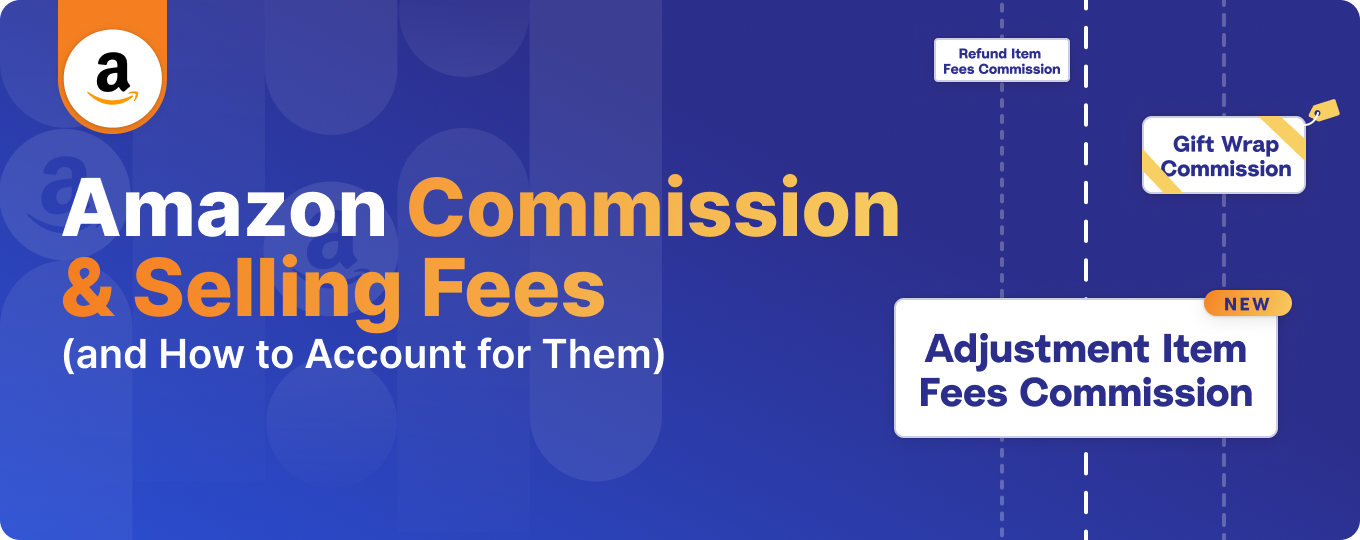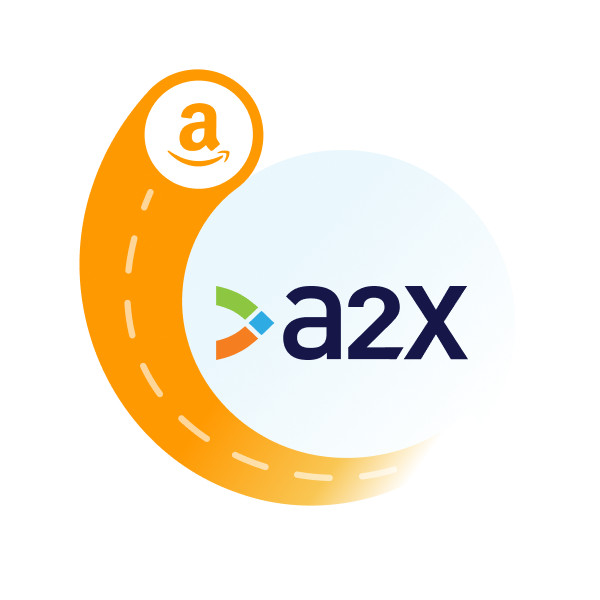Amazon Commission and Selling Fees (and How to Account for Them)
Written by: Elspeth Cordray
February 28, 2025 • 8 min read

Updated on February 28, 2025.
If you sell on Amazon, you’re likely aware of the fees that come along with selling on the platform. Amazon’s fee structure addresses every nuance of the selling process, from post-sale adjustments to order-specific services like gift wrapping.
Amazon commission and selling fees are a category of fees that are important to understand and track because they are usually specific to product types and/or prices, and can therefore have a large impact on profit margins.
In this guide, we’ll continue our series on how to account for different categories of Amazon transactions, and provide a deep dive into how to identify, record, and account for Amazon commission and selling fees.
Key takeaways:
- Amazon charges a referral fee on every sale, which varies by product category and may include a minimum fee. The fee is a percentage of the total sale price (including shipping and gift wrapping), with some categories charging up to 45%. If the calculated fee is lower than the category’s minimum, the minimum fee applies.
- Tracking fees accurately helps sellers set competitive prices, manage costs, and maximize profits. Understanding these fees allows sellers to adjust pricing strategies, optimize product selection, and ensure profitability by considering all selling costs, including commissions on refunds and adjustments.
- Automating fee tracking and bookkeeping helps ensure accurate financial records and saves time. Using tools such as A2X that integrate with accounting software can simplify tracking Amazon fees, reduce errors, and make financial reconciliation more efficient.
What are Amazon commission and selling fees?
Amazon commission and selling fees – also known as referral fees – are the fees that Amazon charges as commission for every item sold.
Commission and selling fees are charged based on the category of the item you’re selling. It’s typically a percentage of the item’s total sale price, including the item price, shipping charges, and any gift-wrapping fees.
The percentage varies by category, with some categories having a minimum fee. When there is an applicable per-item minimum fee, Amazon will deduct whichever amount is greater: the referral percentage or the minimum fee.
For example, let’s say you are selling products within the Clothing and Accessories category. If the referral fee for this category was 17%, and if the minimum referral fee for this category was $0.40:
- If you’re selling a scarf for $50, with $5 for shipping and no gift-wrapping fees: The total sale price would be $55 ($50 + $5). The referral fee at 17% of $55 would be: $55 × 0.17 = $9.35 In this case, the seller would pay Amazon a referral fee of $9.35.
- If you’re selling a small accessory, like a button pin, for $1.50, with $0.50 for shipping and no gift-wrapping fees: The total sale price would be $2 ($1.50 + $0.50). The referral fee at 17% of $2 would be: $2 × 0.17 = $0.34 However, since $0.34 is less than the minimum referral fee of $0.40, the seller would be charged $0.40 instead of $0.34.
Some categories have commission fees as high as 45% or more. Check Amazon’s website to better understand the fee information for your product category and in the region(s) you sell in.
Examples of commission and selling fees
Commission and selling fees will show up on your Amazon Seller statement under a few different transaction types, some of which are listed below.
The core charge for Amazon’s commission fees will usually be labeled as “Order Item Fees Commission”, which captures the referral cost for the item sale (as illustrated in the Clothing and Accessories example provided above).
However, as you’ll see in the list below, the way Amazon’s commission and selling fees are actually broken out can be complex, and there can be commissions and selling fees applied to other selling activities.
Adjustment Item Fees Commission | Fees for adjustments to inventory, including product changes, misplacement, ownership corrections, or found inventory. |
Adjustment Item Fees Refund Commission | A fee retained by Amazon for administering refunds. |
Refund Item Fees Commission | Amazon's fee on refunded items. |
Order Item Fees Commission | Fee charged by Amazon for items sold on their platform. |
Order Item Fees Gift Wrap Commission | Fee for gift wrapping services provided by Amazon for FBA sellers who offer this option. |
A-to-z Guarantee Refund Item Fees Commission | A commission charged by Amazon when intervening in disputes between third-party sellers and customers under the A-to-z Guarantee. |
A-to-z Guarantee Refund Item Fees Refund Commission | Fee reversal for the original referral fee when an A-to-z Guarantee claim is approved, though other costs may still apply. |
Liquidations Adjustments Item Fees Liquidations Brokerage Fee | A fee for handling or brokerage of items being liquidated on Amazon. |
Liquidations Item Fees Liquidations Brokerage Fee | Charges for using Amazon to liquidate inventory, covering facilitation and handling fees. |
We recommend consulting Amazon Seller Central for more information about particular transactions that might be related to your store.
Why does accurate accounting for commission and selling fees matter?
Knowing your commission fees inside and out won’t just help you better understand your cost of selling. It will equip you with knowledge that can influence:
- Your product pricing strategies – E.g., by setting prices that can help you achieve your desired profit margins, strategically offer promotions or discounts, and/or design product bundles and upsell strategies.
- Competitiveness in the marketplace – E.g., by enabling you to price competitively while offering more value to customers. You could also consider diversifying or expanding your product line(s).
- Overall profitability – E.g., by enabling you to better manage costs, prioritize stocking products with better profit margins, forecast more accurately, and notice any discrepancies or errors.
Accounting for Amazon commission and selling fees using A2X
Getting the insights you need to experience the benefits listed above means keeping up with the bookkeeping for your Amazon store.
Fortunately, A2X can help you automate your Amazon store’s accounting and bookkeeping, which can help you save time and ensure accuracy.
Here’s a quick overview of A2X, and read on below to learn how you can set it up.
1. Set up A2X
If you haven’t already, sign up for A2X.
Connect your accounting software (e.g., QuickBooks Online or Xero) to A2X.
Then, connect A2X to Amazon Seller Central.
2. Complete ‘Account and Taxes’ mapping in A2X
Go to A2X’s ‘Accounts and Taxes’ section.
This is where you can assign – or “map” – each Amazon fee type to the corresponding Chart of Accounts in your accounting software. Use A2X’s Auto Setup feature to quickly and easily complete your mappings. (You can adjust them after, if you need to.)
Here’s how A2X would typically map the commission and selling fee examples that we provided earlier. Important: We recommend working with a specialized ecommerce accountant to make sure you have mapping set up correctly for your specific business needs.
Fee name | A2X Default Account | Account Type |
Adjustment Item Fees Commission | Amazon Seller Fees and Charges | Expense |
Adjustment Item Fees Refund Commission | Amazon Seller Fees and Charges | Expense |
Refund Item Fees Commission | Amazon Seller Fees and Charges | Expense |
Order Item Fees Commission | Amazon Seller Fees and Charges | Expense |
Order Item Fees Gift Wrap Commission | Amazon Seller Fees and Charges | Expense |
A-to-z Guarantee Refund Item Fees Commission | Amazon Seller Fees and Charges | Expense |
A-to-z Guarantee Refund Item Fees Refund Commission | Amazon Seller Fees and Charges | Expense |
Liquidations Adjustments Item Fees | Amazon Seller Fees and Charges | Expense |
Liquidations Brokerage Fee | Amazon Seller Fees and Charges | Expense |
Liquidations Item Fees Liquidations Brokerage Fee | Amazon Seller Fees and Charges | Expense |
If you’re selling on multiple marketplaces in different countries, you might also see a country or marketplace breakdown of your data.
3. Review and post
Navigate to the ‘Settlements’ page in A2X, where all of your Amazon settlements fetched by A2X are listed.
Select ‘Review’ for each settlement to view its detailed transactions, the total amount, the designated account, and the assigned tax rate (if applied).
If everything looks good, click on ‘Send to [Your Accounting Software]’.
4. Reconcile in your accounting software
Log in to your accounting software and spot the settlement that A2X recently sent in your bank feed.
Double-check that the numbers tally up, then go ahead and reconcile.
5. Make bookkeeping a regular practice
Consistent bookkeeping is key! Make it a habit to use A2X to make sure that every Amazon settlement reconciles with the corresponding bank deposit. You can also use A2X’s Auto-Posting feature to automate your Amazon bookkeeping even more.
With accurate and up-to-date bookkeeping, you can get accurate and up-to-date P&L reports to better understand how your business is performing, and any changes you might need to make to increase profitability or reach your other business goals!
Get accurate and automated Amazon accounting with A2X
Ready to make sense of your Amazon transactions and get your books in order? Sign up for a free trial and integrate A2X with QuickBooks Online or A2X with Xero today!
Learn more about Amazon seller fees and transactions and how to account for them:
- Amazon Order Revenue Transactions (and How to Account for Them)
- Amazon Delivery and Transport Fees (and How to Account for Them)
- Amazon Fulfillment and Storage Fees (and How to Account for Them)
- Amazon Subscription Fees (and How to Account for Them)
- Amazon Reserve Balances (and How to Account for Them)
- Amazon Reimbursements (and How to Account for Them)
Frequently Asked Questions

Integrate Amazon and your accounting software for accurate accounting
A2X auto-categorizes your Amazon sales, fees, taxes, and more into accurate summaries that make reconciliation in your general ledger a breeze.
Try A2X today
